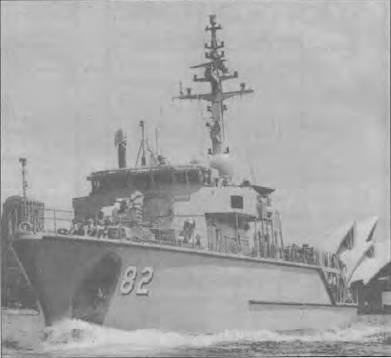- Author
- A.N. Other and NHSA Webmaster
- Subjects
- Ship design and development
- Tags
-
- RAN Ships
- HMAS Gascoyne II, HMAS Huon II
- Publication
- March 2000 edition of the Naval Historical Review (all rights reserved)
The first of this new class of minehunters, HMAS Huon, was handed over to the RAN on 25 March 1999 after a series of successful sea trials, “the major milestone in the whole process of preparing a warship for service”. Initially, these included trials of engine and generators and the minehunting sonar.

For the latter, a dummy minefield was laid off Newcastle and the sonar was required to detect the mines and then classify them. The minehunting auto pilot was also tested. This system enables a ship to follow a predetermined track through an area likely to be mined. The auto pilot steers the ship through the possible minefield and allows it to “hover” over programmed points. If the sonar makes a contact, one of the ship’s two mine disposal vehicles can be despatched to determine if it is a mine. Electrically powered, the vehicles are equipped with a mine disposal charge, searchlights, closed circuit television cameras, sonar, and are controlled via a fibre optic link. They can be deployed more than 500 metres from the ship. In August 1998 the integration and testing of the minehunters’ combat system was completed on shore in the ADI facility at Newcastle. It was transferred in 1999 to HMAS Waterhen to be used as a training centre.
The whole project is a highly complex electronic systems task, which ADI’s Managing Director, Mr Ken Harris, says has “turned the conventional notion of ship building on its head”. Basically it is a collection of electronic systems which are proven on shore and the supporting software not installed until the ship has been launched.
There is a 76% Australian industry involvement in the project – the local content requirement being only 60% minimum and local industry will thereafter maintain the six Huon class ships. The risk of failure of any part of the ship’s equipment has been minimised by the shore integration facility. It has allowed the builders to determine that all the systems are functioning satisfactorily before they are installed on board.
ADI has been able to boost Australian industry involvement in the project with contracts totalling $650 million awarded to Australian subcontractors including more than $500m to New South Wales businesses.
To the lay person, the construction of these six vessels could be likened to a mini mass production assembly line. The hull is formed in a large mould, and then withdrawn to a nearby position, still within the covered workplace, to receive its engines and associated auxiliaries. In the vacant mould workmen begin to form ship No. 2. The first ship is then hauled to the hard-standing outside, for the addition of prefabricated sections; thereafter in her cradle she is moved to her launching position for final prelaunching work before actually taking to the water. Meanwhile, ship No. 2 is on the hard-standing, ship No. 3 is just out of the mould and the hull of ship No. 4 is being formed in the mould.
When production of the last ship Yarra commenced in the mould in June last year, Diamantina was receiving its engines, Gascoyne was on the hard-standing, Norman was fitting out alongside, Hawkesbury was completing sea trials and Huon had been commissioned into the RAN.
Minehunter HMAS GASCOYNE: Update
HMAS Gascoyne, fourth in a series of six Huon class minehunters, was launched on Newcastle Harbour March 2000. The $100 million-plus Royal Australian Navy ship was christened by Victoria Peel, daughter of the late Captain John Peel, who commanded the original HMAS Gascoyne, the first antisubmarine frigate built in Australia, between 1944 and 1946. The minehunter project will run until 2003, with two more ships on the way.




